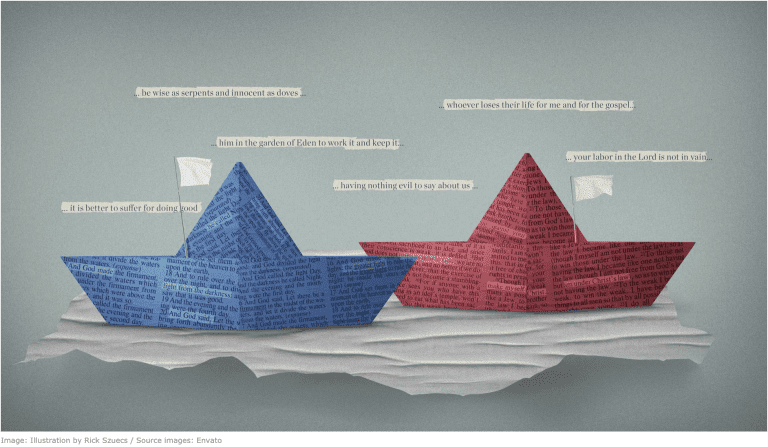There is an entire generation of people who can sing nearly every lyric of Vanilla Ice’s Ice Ice Baby but struggle to memorize Scripture, remember key points of doctrine, or contextualize the gospel. No, I’m not trying to put anyone to shame. It’s just a straightforward observation.
Actually, I think Vanilla Ice has a lot to teach us besides dance moves and lyrical poetry.
It’s pretty well-known that he borrowed (stole?) from Queen and David Bowie’s Under Pressure. Supposedly, he claims it was different because he added an extra beat to the rhythm. In any case, when you hear the two songs side by side, the likeness between the two songs is apparent. I’ve provided the link above so you can hear the comparison for yourself.
When you hear the two songs, one can’t help but think, “I’ve heard that before.” Depending on your generation, you’ll hear Under Pressure and think it’s Ice Ice Baby (or vice versa).
Hearing Our Story in the Biblical Story
When we contextualize biblical truth, a similar dynamic should be at work. Gospel presentations may vary in their exact language––their word pictures, metaphors, and themes. However, our words (i.e. “lyrics”) still have to match the rhythm of the Scripture.
Before going too far with the analogy, let me define the terms. The “music” represents the biblical story which rings true across generations and cultures. The “music” is as rich as it is universal. The “lyrics” represent particular ways of articulating truth.
When we contextualize the gospel, our presentations have to fit the grand story of Scripture. In other words, our lyrics must fit the music. We have to tell the gospel so that it accords with the whole narrative.
When people hear one telling of the gospel, they should begin to hear the backbeat and rhythm that is familiar to every human being made in the image of God. Just as people think of Under Pressure when they hear Ice Ice Baby, in the same way people should hear echoes of their own story when they hear the biblical story.
This is the effect of contextualization, if it’s done well. However the particular words may change, everyone is reminded of and drawn to the music that lie behind it.
We have to be careful that we don’t use “lyrics” in our contextualizations that wind up usurping the “music” of biblical theology. While we have tremendous creative license, it is bound by Scripture. On the other hand, we can’t limit what can be said simply to those lyrics we prefer. Those who grew up in the 70s have little idea what these words mean or where they come from,
All right stop
Collaborate and listen
Ice is back with my brand new invention
Something grabs a hold of me tightly
Then I flow that a harpoon daily and nightly
Will it ever stop?
Yo, I don’t know
Turn off the lights and I’ll glow
To the extreme I rock a mic like a vandal
Light up a stage and wax a chump like a candle
When the older generation hears the music, they think of other lyrics and are ready to dance. Perhaps, they are the better for it.
The Bible is the absolute standard that bounds what we preach. We cannot say anything we want. The lyrics may be adjusted to fit the generation and context. However, they ultimately have to find their coherence with the grand story of Scripture.
If we really do this, then people from every nation will hear something they can recognize––that same story that rests within human hearts, echoing back to God’s own creation song, which reminds us not only of where we have been but also where we long to go.
In Saving God’s Face, I speak of the problem of assuming the gospel, as it is prominent with evangelicalism. People favor one particular expression of the gospel to the point that one truncates the grand narrative of Scripture.
This is akin to letting the words drive the music. If we let the words drive the music, we wind up singing something akin to Suzanne Vega’s Tom’s Diner (with the chorus “duh–duh– duh–duh….duh–duh–duh–duh…duh–duh–duh–duh–duh–duh–duh“). It’s not a bad song, but the Scripture is a bit more diverse than this lyrical doldrums.
Help People Hear the Music behind the Lyrics
The Bible is not a systematic textbook of philosophical truths. It is far more comparable to a work of art. It tells the story of God’s creation, preservation, and restoration of the world through Christ.
Amid all its complexity, there is a rich beauty that communicates better than any list of doctrines ever could. The writers overlay one theme with another, stringing together an account of the history that connects with every culture in the world. It’s the universal story of the world that never sacrifices particularity.
The “music” of Scripture is more than the words on the page. In any song, one could not hear the drums, the bass, and the electric guitar in isolation from the others and think one has heard the song. Scripture, like a song, is more than the sum of its fragmented parts.













